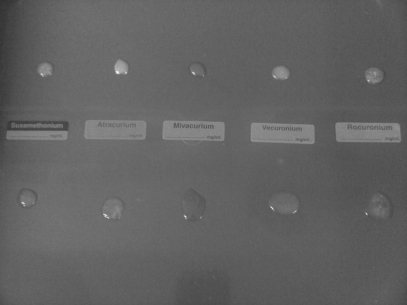Potentially harmful, yet avoidable, interaction between thiopentone and commonly used muscle relaxants can endanger patients.
Case report
We report an interesting phenomenon we recently encountered in our hospital. Our patient was a healthy man who came in for an emergency hernia repair due to suspected obstruction. Previous anaesthesia for an orthopaedic operation the previous year had been uneventful. The plan was to anaesthetize him with a rapid sequence induction. This was done in view of the increased risk of aspiration given that he was obstructed.
It was decided to use a modified rapid sequence induction with rocuronium and thiopental sodium.
The induction was uneventful; pre-oxygenation was followed by 375 mg of sodium thiopental and 40 mg of rocuronium through a 20 G cannula connected to a 1000 mL Hartmann's solution. Upon intubation it was noted that the patient was not fully relaxed despite an appropriate dose of relaxant.
We then noticed that our previously free running Hartmann's infusion had stopped and that there was a 10 cm long column of a fluid containing a flaky precipitate in the IV line. Efforts to flush the line with 10 mL of saline through the injection port were unsuccessful.
The patient was re-cannulated on the opposite hand, and a dose of suxamethonium was given to aid fast muscle relaxation with cricoid pressure still in place. The patient was then intubated without any harm. Surgery, subsequent extubation and recovery period were uneventful and the patient was discharged home later that day. The initial cannula was removed and examined more closely to show that the lumen had indeed occluded by the flaky precipitate.
Following this clinical scenario we carried out some simple experiments. We drew up a syringe of commonly used muscle relaxants and pipetted five 1 mL aliquots onto a flat, sterile surface. To each of these we then added 1 mL of sodium thiopental to see their interaction in vitro. The results are shown in Figure 1.
Figure 1.
Interaction between thiopental and a variety of muscle relaxants (top row) and then with addition of Hartmann's solution (bottom row). From left to right: Suxamethonium, Atracurium, Mivacurium, Vecuronium, Rocuronium
Whereas the interaction with mivacurium produced practically no reaction, this did not appear to be the case with the other relaxants we tested. Suxamethonium produced a mild precipitate, followed by atracurium. Vecuronium and rocuronium, however, produced a rather marked crystallization, producing macroscopically visible precipitates. This may have been responsible for our scenario where rocuronium given through a poorly flowing cannula may have led to crystallization of thiopental and subsequent occlusion of the cannula/vessel.
To further test how dilution effected the crystallization we added small amounts of Hartmann's solution to see if the precipitate would re-dissolve (if at all).
Mixing with Hartmann's solution brings about some degree of dilution, however, no evident dissolving of the crystals. Rocuronium, in particular, still produced a considerably flaky precipitate.
Discussion
Although a rudimentary experiment, we believe it highlights a potentially harmful interaction between two very commonly used anaesthetic drugs; one which we believe many anaesthetists may well be unaware of. In particular, when using rocuronium for rapid sequence, which we feel is becoming more common practice, loss of IV access when only half the required drug has been administered can lead to unnecessary complications and difficulty.
Literature search on the subject showed that a few cases of precipitation of thiopental following administration of certain muscle relaxants have been reported.1–3 The interaction seems to be a result of the differing pH of the two drugs (Table 1).
Table 1.
pH of thiopental and commonly used muscle relaxants
| Drug | pH |
|---|---|
| Thiopentone | 11–12 |
| Suxamethonium | 3.5 |
| Mivacurium | 4.0–5.0 |
| Vecuronium | 4.0 |
| Atracurium | 3.5 |
| Rocuronium | 4.0 |
There seems to be some correlation between the relative difference in pH and the amount of crystallization observed. Mivacurium, closest in pH to thiopentone shows the least precipitation compared with the other more acidic muscle relaxants. The precipitate for the reaction has been shown by UV spectrophotometry to be thiopentone acid,4 and subsequent studies have shown that it is highly insoluble in human plasma (<0.1 mg mL−1), especially when compared with thiopental (700 mg mLl−1).3
Given the very common scenario in which these drugs are used in combination, namely induction and intubation, the importance of avoiding complications at this crucial stage cannot be overstated. Blocking off intravenous access in an emergency situation is a dangerous prospect. As well as this injecting an insoluble precipitate into the circulation could, in our opinion, have harmful sequelae.
We feel a combination of a free-flowing drip as well as fluids running through it can minimize potential difficulties. When no fluids are being administered, then a generous saline flush may well suffice to clear cannula and vessel of thiopental, prior to administration of muscle relaxant. Another potential solution is to alter the drugs used. No reports were found with crystallization and/or blockage of cannula/vessel when modified rapid sequence was performed with propofol and any of the muscle relaxant.
DECLARATIONS
Competing interests
None declared
Funding
None
Ethical approval
Written informed consent to publication was obtained from the patient or next of kin
Guarantor
SK
Contributorship
All authors contributed equally
Acknowledgements
The authors thank the Department of Anaesthetics at Horton General Hospital, Banbury for their help and advice with the study
Reviewer
Jonathan Collins
References
- 1.Schmidt U, Basta SR, Shank ES Precipitation of thiopental by rapacuronium. Anesthesiology 2001;95:273 [DOI] [PubMed] [Google Scholar]
- 2.Chambi D, Omoigui D Precipitation of thiopental by some muscle relaxants. Anesth Analg 1995;81:1112 [DOI] [PubMed] [Google Scholar]
- 3.Taniguchi T, Yamamoto K, Kobayash T The precipitate formed by thiopentone and vecuronium. Can J Anaesth 1996;43:511–13 [DOI] [PubMed] [Google Scholar]
- 4.Morton WD, Lerman J The effect of pancuronuim on the solubility of aqueous thiopentone. Can J Anaesth 1987;34:87–9 [DOI] [PubMed] [Google Scholar]



